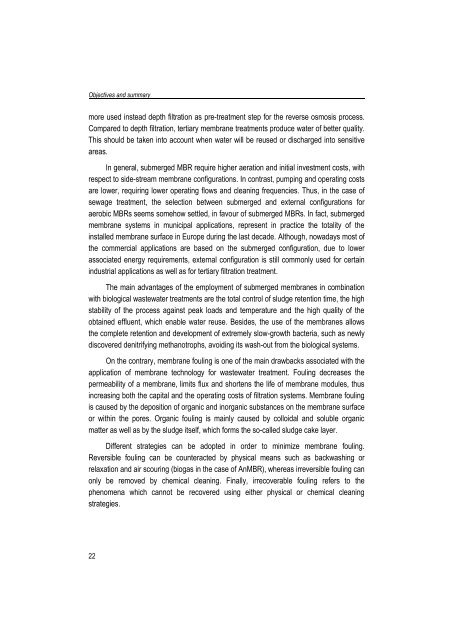Combining submerged membrane technology with anaerobic and ...
Combining submerged membrane technology with anaerobic and ...
Combining submerged membrane technology with anaerobic and ...
Create successful ePaper yourself
Turn your PDF publications into a flip-book with our unique Google optimized e-Paper software.
Objectives <strong>and</strong> summarymore used instead depth filtration as pre-treatment step for the reverse osmosis process.Compared to depth filtration, tertiary <strong>membrane</strong> treatments produce water of better quality.This should be taken into account when water will be reused or discharged into sensitiveareas.In general, <strong>submerged</strong> MBR require higher aeration <strong>and</strong> initial investment costs, <strong>with</strong>respect to side-stream <strong>membrane</strong> configurations. In contrast, pumping <strong>and</strong> operating costsare lower, requiring lower operating flows <strong>and</strong> cleaning frequencies. Thus, in the case ofsewage treatment, the selection between <strong>submerged</strong> <strong>and</strong> external configurations foraerobic MBRs seems somehow settled, in favour of <strong>submerged</strong> MBRs. In fact, <strong>submerged</strong><strong>membrane</strong> systems in municipal applications, represent in practice the totality of theinstalled <strong>membrane</strong> surface in Europe during the last decade. Although, nowadays most ofthe commercial applications are based on the <strong>submerged</strong> configuration, due to lowerassociated energy requirements, external configuration is still commonly used for certainindustrial applications as well as for tertiary filtration treatment.The main advantages of the employment of <strong>submerged</strong> <strong>membrane</strong>s in combination<strong>with</strong> biological wastewater treatments are the total control of sludge retention time, the highstability of the process against peak loads <strong>and</strong> temperature <strong>and</strong> the high quality of theobtained effluent, which enable water reuse. Besides, the use of the <strong>membrane</strong>s allowsthe complete retention <strong>and</strong> development of extremely slow-growth bacteria, such as newlydiscovered denitrifying methanotrophs, avoiding its wash-out from the biological systems.On the contrary, <strong>membrane</strong> fouling is one of the main drawbacks associated <strong>with</strong> theapplication of <strong>membrane</strong> <strong>technology</strong> for wastewater treatment. Fouling decreases thepermeability of a <strong>membrane</strong>, limits flux <strong>and</strong> shortens the life of <strong>membrane</strong> modules, thusincreasing both the capital <strong>and</strong> the operating costs of filtration systems. Membrane foulingis caused by the deposition of organic <strong>and</strong> inorganic substances on the <strong>membrane</strong> surfaceor <strong>with</strong>in the pores. Organic fouling is mainly caused by colloidal <strong>and</strong> soluble organicmatter as well as by the sludge itself, which forms the so-called sludge cake layer.Different strategies can be adopted in order to minimize <strong>membrane</strong> fouling.Reversible fouling can be counteracted by physical means such as backwashing orrelaxation <strong>and</strong> air scouring (biogas in the case of AnMBR), whereas irreversible fouling canonly be removed by chemical cleaning. Finally, irrecoverable fouling refers to thephenomena which cannot be recovered using either physical or chemical cleaningstrategies.22
















